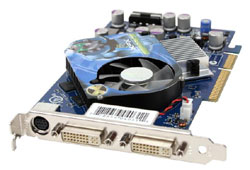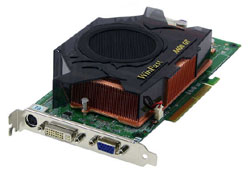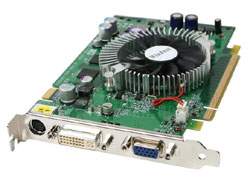Buyer's Guide - Mid-Range, January 2005
by Jarred Walton on January 21, 2005 11:09 AM EST- Posted in
- Guides
Video Card Recommendations
The ups and downs of SLI are becoming more apparent as time passes. There have been some reports of general flakiness with SLI setups, particularly if you're using the DVI connection of your graphics card. Applications ("games" in reality, as we're not aware of any optimizations for non-gaming programs) require hard-coded driver support in order to use SLI; if NVIDIA hasn't yet profiled a game, SLI systems will render using only one video card. You can still purchase an SLI motherboard, but our recommendations here are concerned with Mid-Range price/performance, and SLI - and particularly high-performance PCIe cards - does not fit well in this price segment. Remember that for Intel, we give the PCIe configuration a full recommendation, but for AMD, we're still hesitant. We'll start with the AGP side of things.
AGP Recommendation
XFX 6600GT AGP 128MB GDDR3Price: $209 Shipped
The selection of 6600GT cards in AGP format is beginning to improve, as is the price. While it may not be the cheapest option available, we like the features that the XFX 6600GT 128MB [RTPE: PVT43AND] brings to the table. Specifically, the dual DVI output is a great inclusion for the future. If you don't have an LCD yet, you can use an adapter to run a standard VGA connection, but for LCD users, you will definitely want to get a DVI capable display and graphics card. The ability to run dual LCD displays - and if you're going to use two displays, we strongly recommend LCDs due to their space saving characteristics - would thus require two DVI ports, or else you would have to run with the lower quality VGA connection on one display. Is it absolutely necessary? No, but for an extra $10, we prefer the capability, just in case. An added benefit is that the XFX is clocked at 500 MHz on both the core and the memory; the official specification for the AGP 6600GT cards has the RAM clocked at 450 MHz, unlike the PCIe models. Granted, with overclocking, you could probably push any of the cards to 500 MHz and even further, but for an out-of-box experience, we like the manufacturer-approved "overclock".
There is one noteable drawback to the XFX card, unfortunately. It is relatively loud. We're not talking FX 5800 Ultra levels, by any means, but it is definitely audible. If you want something quieter and are willing to lose the dual-DVI and factory overclock options, MSI makes a very good 6600GT card that is near-silent in comparison. BFG also makes a good card that includes even more factory overclocking than the XFX, but it costs almost as much as a 6800 card, so unless the price drops to match the other 6600GT cards, it is difficult to recommend.
AGP Alternative
Leadtek A400GT TDH 256MB GDDR3Price: $377 Shipped
If you're truly interested in performance without breaking the bank, the best Mid-Range option to get you there remains with the AGP GeForce 6800GT [RTPE: A400 GT TDH]. The Leadtek cards also include a large, two-slot copper heatsink, which should help to keep the card cool. If you like our above recommendation to get a dual-DVI card where possible, you'll have to spend $30 more to get an XFX card. Lately, XFX has started to make a point of offering dual DVI output on all their cards. They do have some 6800GT cards with a VGA/DVI output for less money, but nearly all of their new cards are now dual-DVI.
For an in-between alternative, the 12 pipeline 6800 cards are also viable. They're not tremendously faster than the 6600GT - in fact, in terms of pixel processing power, it's basically a tie between the two chips - but they do have a 256-bit memory interface that can help out quite a bit in certain applications. For a price that's pretty much right in line with the performance increase/decrease relative to the 6600GT and the 6800GT, the BFG 6800 OC [RTPE: BFGR6800] would be our pick. Depending on your location, it can be had for as little as $259.
PCIe Recommendation
Leadtek Winfast PX6600GT TDH PCIe 128MBPrice: $190 Shipped
If you want to get a PCI Express system, the only reasonably mid-range option is the 6600GT. The 6800 PCIe cards carry a large price premium at present, so they remain high-end options. We recommend that anyone who is looking at the 6600GT cards should read our 6600GT roundup. One of the key stumbling blocks for a lot of the cards was a poorly mounted HSF, which could cause problems if you swap hardware a lot or move your computer around much. Basically, the advice for most of the 6600GT cards is "handle with care". Our recommendation goes to the Leadtek 6600GT [RTPE: PX6600GT TDH], the Gold Editor's Choice card from the roundup. The card runs cool and quiet, overclocking is decent - about in line with most of the other cards - and the HSF is mounted securely. Again, dual-DVI is an option with the XFX model [RTPE: PVT43GND], which was our runner-up Silver Editor's Choice. It wasn't without issues, noise being one of them, but there aren't many options that we're comfortable recommending at this point which have dual-DVI.
Despite all of our talk about SLI not offering much, it is an option some will like. It doesn't save you much over the long term relative to AGP, but it's better than nothing. We're really looking forward to the actual retail availability of ATI's X800 and X800XL cards, which are supposed to target prices of $199 and $299 respectively. It may take two months for them to actually reach that price, if the trends of the past few months continue, but they do bring some needed competition to the low- to mid-range PCIe segment. Serious ATI fans who are looking for good value really have only one option right now, the X700 Pro [RTPE: X700 Pro]. While the 256 MB of RAM might seem attractive, it really doesn't help that much and we would prefer a faster core and RAM rather than more RAM running at slower speeds. The X700 XT, unfortunately, has been removed from ATI's lineup, so you'll have to wait for the X800. For top PCIe performance, the 6800GT PCIe card with an eye towards SLI would make sense, but the $475 price point per card is $100 more than its AGP counterpart and well into the high-end segment.













46 Comments
View All Comments
JarredWalton - Wednesday, January 26, 2005 - link
^^^ Er, Foxconn is at MonarchComputer.com, not GameVE.JarredWalton - Wednesday, January 26, 2005 - link
44 - This was written by January 18th and published Jan 21st. Things change rapidly, which is why the Buyer's Guides are really just a snapshot in time. There are several NF4 boards now available at Newegg, including the Chaintech and an MSI Neo4 Platinum. Odd that the Chaintech lists "NVIDIA 7.1-channel audio" - is SoundStorm back with NF4? I don't think I had heard about that. The Gigabyte board is also available from quite a few other resellers besides Newegg, of course. There's even a $109 Foxconn NF4 board at GameVE. Interesting! Not that I've had any good Foxconn experiences, but $109 is attractive.jleandro - Wednesday, January 26, 2005 - link
Don't want to be a pain, you guys review whatever boards you think are worthy, but I just checked Newegg and here's what they had IN STOCK:CHAINTECH NVIDIA nForce4 Ultra Chipset Motherboard For AMD Socket 939 CPU, Model "VNF4/Ultra" -RETAIL US$ 135
MSI "K8N Neo4 Platinum" NVIDIA nForce4 Ultra Chipset Motherboard For AMD Socket 939 CPU -RETAIL US$ 159
GIGABYTE "GA-K8NXP-SLI" NVIDIA nForce4 SLI Chipset Motherboard For AMD Socket 939 CPU -RETAIL US$ 249
ASUS "A8N-SLI Deluxe" nForce4 SLI Chipset Motherboard For AMD Socket 939 CPU -RETAIL US$ 265
Interesting that the Gigabyte K8NF-9 was actually not in stock.
hawksballer - Tuesday, January 25, 2005 - link
JarredWalton - Monday, January 24, 2005 - link
41 - Guide editors changed a few months back. The "alternative" configurations have always been more expensive, and they include *all* the alternatives, usually. If you were to take this Guide's alternative (NF4) and stick with the recommend parts everywhere else, price would drop considerably. I haven't made a point of highlighting this, but I did change the pricing targets a bit on the Guides.For the budget, I typically try for $500, but I usually end up closer to $600. Compromises to drop the price are possible but undesirable, i.e. go with 1x256 MB of RAM. The Budget altenative I generally target slightly below the Mid-Range, so $900 to $1000 is usually where it lands.
The Mid-Range has been bumped to $1250 by default, which generally allows for a very good all-around system with few (if any) compromises. The alternative Mid-Range I try to keep under $2000, although closer to $1750 is desirable.
I haven't done any High-End or OC Guides, but High-End will be in the $2000+ range (maxing out at $4000 or so with *all* the trimmings), and the OC Guide is really just about any of the above price goals. I'm working on one of those.
Hopefully that answers your questions. If you want to trim costs a bit on the Mid-Range, going to a slower CPU and GPU usually cuts close to $200, but then it's no longer an all-around system.
-------------
#40: The Chaintech may very well be available in Hungary, but it is not at all available in the US right now. Newegg is the one of the few sites that even list it, and any boards have disappeared *FAST*. If you picked on up without difficulty where you live, more power to you! Lucky #@$^&*%! ;)
wilburpan - Monday, January 24, 2005 - link
Is it just me, or have the Mid-Range and Entry Level Buyer's Guides suffered from price inflation? It seems to me that way back when, the price points for these two were a solid $1000 and $500, respectively. Now the Entry Level Guide has a budget of up to $1000, while the Mid-Range Guide is pushing $2000.I can understand that picking price points is an arbitrary process, but I would think that for comparing what your computer dollar buys you over tme, it would be nice to remain consistent.
jleandro - Monday, January 24, 2005 - link
Can't understand why the Chanitech NF4 Ultra Zenith is not considered to be available.I live in Hungary (not the prime tech spot) and this board has been available for some time, most retailers have it.
In fact I just bought one today for ~110 USD and will pick it up tomorrow.
For instance, check http://www.e-connect.hu under "alaplapok" (motherboard in Hungarian).
JarredWalton - Monday, January 24, 2005 - link
38 - Thanks. It's corrected now. The marketing for the drive states "with SATA-II features" and somewhere along the line that got put in as SATA-II. :| Basically, the drive has hot-swap capability and NCQ, which are both SATA-II. It does not support 300MB/s, but then burst transfer rates really matter much. With sustained transfer rates of even the fastest drives maxing out around 70 MB/s, it will be quite some time before SATA-II transfer rates really show real-world benefit.37 - 0dB computing? I'm not sure I'm the one to address that, but it's certainly something to think about. I'll pass that along and see if we can acquire the parts for such a test. They're relatively expensive in comparison to fan-based solutions, unfortunately.
AnnihilatorX - Monday, January 24, 2005 - link
JarredWalton:A misleading information I just found and thought would like to point out...
The Maxtor Diamond Max 10 300GB with NCQ 16MB cache (6B300S0) is SATA-I/150 in terms of transfer speed, but not SATA-II/300 as stated in page 6.
http://www.anandtech.com/guides/showdoc.aspx?i=232...
"Maxtor 300GB SATA-II with NCQ and 16MB cache"
ceefka - Monday, January 24, 2005 - link
Again a great guide. I was already interested in the Maxtor 300 GB SATA II. I guess in that case you'll have to go with the Gigabyte GA-K8NF-9 or any of the other nForce 4 boards.Would it be a challenge for AT to build a 0dB PC with high end components with Intel and AMD and compare notes. This machine should at least be a mid-range performer or just as high as you can go on 0dB.
I wonder because I'd like to build something really quiet. I have already looked into components like Yesico FL420 and fanless CPU coolers, but I am not sure if all of that will work with also two Maxtor 300GB SATA-II's in http://www.blacknoise.de/shop/de_DE/produkte/id_is...